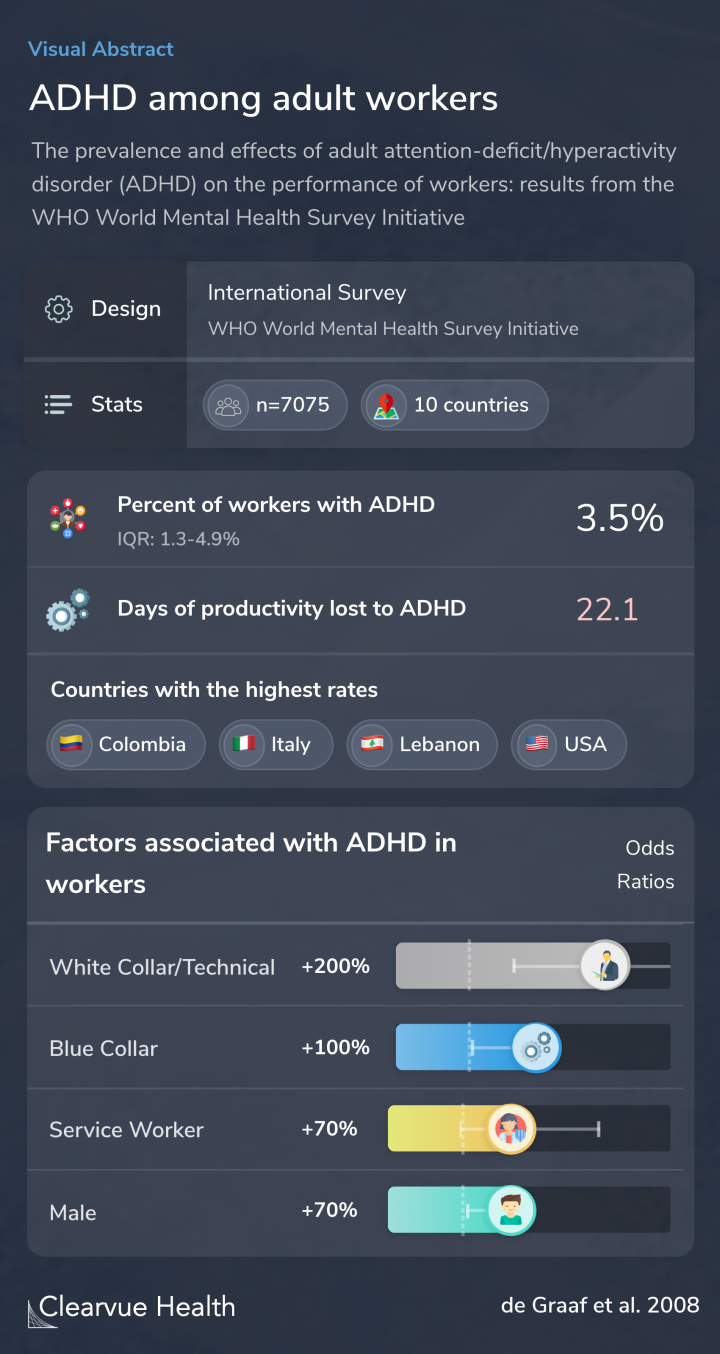The prevalence and effects of adult attention-deficit/hyperactivity disorder (ADHD) on the performance of workers: results from the WHO World Mental Health Survey Initiative
ADHD among adult workers
R de Graaf , R C Kessler, J Fayyad, M ten Have, J Alonso, M Angermeyer, G Borges, K Demyttenaere, I Gasquet, G de Girolamo, J M Haro, R Jin, E G Karam, J Ormel, J Posada-Villa

Objectives
ADHD is a common condition around the world. Previous studies have shown that it can be found in rich and poor countries. ADHD has been closely linked with difficulties in school.
But, there has been less research on the effects of ADHD in the workplace.
This study wanted to gather data on how common ADHD was among workers worldwide and how it impacts productivity and experiences at work.
To estimate the prevalence and workplace consequences of adult attention-deficit/hyperactivity disorder (ADHD).
Methods
The study analyzed data from an ADHD survey administered to adults in 10 countries.
The adults were screened for ADHD symptoms and asked about their jobs.
An ADHD screen was administered to 18-44-year-old respondents in 10 national surveys in the WHO World Mental Health (WMH) Survey Initiative (n = 7075 in paid or self-employment; response rate 45.9-87.7% across countries). Blinded clinical reappraisal interviews were administered in the U...
Results
Researchers found that around 3.5% of adults around the world have ADHD.
This was generally in line with ADHD prevalence globally. However, researchers did find that workers had a lower rate of ADHD in the United States.
On average, each adult lost around 22 days per year of productivity because of their ADHD symptoms.
Colombia, Italy, Lebanon, and the United States had the highest rates of ADHD among workers.
Based on the survey, researchers found that certain types of workers are more likely to have ADHD.
White-collar technical workers and blue-collar workers were at least twice as likely to have ADHD.
An average of 3.5% of workers in the 10 countries were estimated to meet DSM-IV criteria for adult ADHD (inter-quartile range: 1.3-4.9%). ADHD was more common among males than females and less common among professionals than other workers. ADHD was associated with a statistically signifi...
Conclusions
The study results showed that ADHD is common among workers and can significantly impact productivity.
Many of the workers found to have ADHD didn’t know they had ADHD or weren’t being treated for it.
This suggests that treatments and screening for ADHD in workers may be cost-effective interventions.
ADHD is a relatively common condition among working people in the countries studied and is associated with high work impairment in these countries. This impairment, in conjunction with the low treatment rate and the availability of cost-effective therapies, suggests that ADHD would be a ...